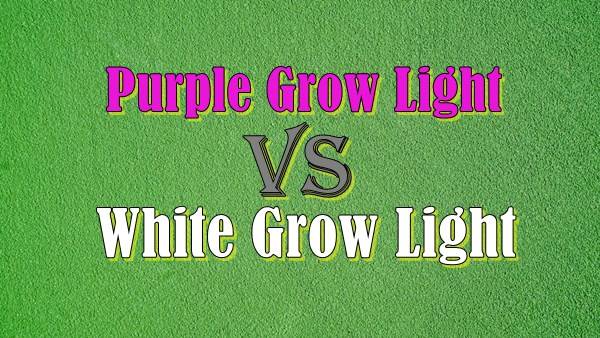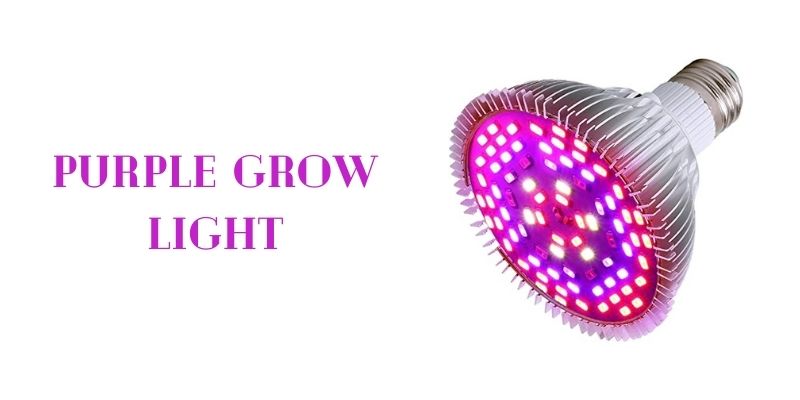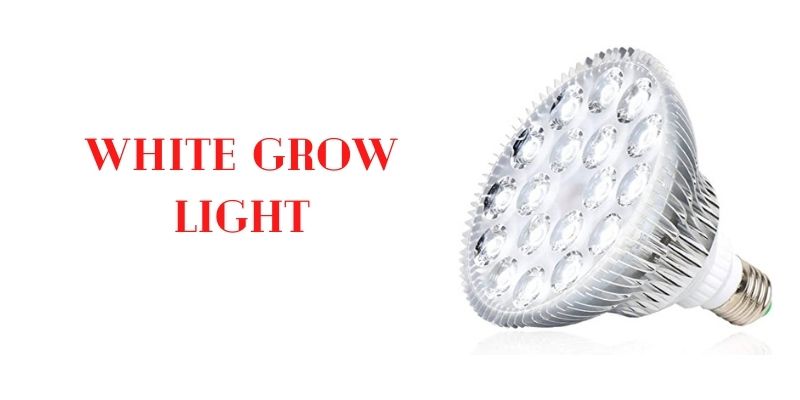In the grow tents or other horticultural setups, there are different types of light-emitting diodes. Two of them are majorly in use in such types of applications. Both of them can emit light of different wavelengths that are useful for different purposes.
One of them is known as the narrowband because it can emit light of blue or red color only.
And the other one is broadband, and it can emit only whitish light. It is a combination of red, blue, and green color light.
Keep in mind that there is no white band in this type of LED light band. Although people think that are white led lights good for growing or not. But the answer lies in the type of use that the grower needs from this type of light.

Table of Contents
Difference Between Purple vs White Grow Light
The white lights are mainly blue light-emitting diodes that have a covering of phosphorous over them. The presence of this substance makes the blue LED light less energetic and increases its wavelength as well. As we use them in the grow tents, so the demand is more for the blue light in comparison to blue light. Also, the use of full-spectrum white LED grow light is very common along with purple light.
Due to high, there have been many advancements in the technology that is making these lights. The white and blue lights are also in common use for grow tents and similar setups. But very few people know what is the difference between them, and which one they should choose.
Here is a snapshot comparison between these two types of lights:
1) Go Green Naturally
Plants grown indoors tend to have lower levels of CO2 and higher levels of O2 because the white lights do not promote photosynthesis as efficiently as the broad spectrum purple LED lights. If climate control is to remain accurate, other options like CO2 supplementation would need to be used in greenhouses with set-ups that use only wide-spectrum lights.
It has been found that plants under low-pressure sodium grow faster and produce more biomass than those under broad-spectrum bulbs. In addition, plants grown with only white light have proven to have lower pigment content which in turn causes visual deficiencies in them such as chlorosis or yellowing. This may lead to issues with animal consumption of plant parts having higher amounts of pigments present in them.
This explains why most people are switching to the use of purple LEDs rather than traditional white grow lights.
2) Improves Plant Growth
A lot of research shows that plants grown under purple light grow faster, bigger and healthier due to increase in CO2 levels and higher Phosphorus content in them along with better photosynthesis efficiency using the light produced by these bulbs as compared to the white LED.
The absence of red and blue light makes photosynthesis occur at a faster rate which results in larger plants that are able to produce more fruit or flower when they grow.
3) Plant Health
As mentioned earlier, since broad-spectrum lights tend to have a higher amount of blue and red light, it affects the process of photosynthesis. This can lead to slow growth, reduced flowering cycles, and yellowing leaves while affecting overall plant health badly ultimately leading to their death.
However purple LEDs do not let this happen due to their ability to cover all wavelengths without having an excess of any color causing an imbalance in other colors present in them.
In addition, if you have decided to go for a high-pressure sodium lighting system because your place is very cold, you should know that these grow lights emit a lot of heat and will ultimately reduce plant growth and health significantly.
4) Increase Yield
Plants grown under white LEDs have been shown to produce only around 1/3rd (33%) of the amount of crop as compared with plants grown under purple LED lights in trials conducted by some greenhouses. This is because more light is absorbed by leaves due to increase in temperature which makes it difficult for plants to get enough energy from them leading to reduced growth rates.
In addition, higher temperatures also lead to reduction in chlorophyll content which becomes evident when consumers are eating fruits or vegetables rich in pigments like tomatoes as they gradually lose their color over time while growing inside homes or greenhouses using such lights.
5) Healthy and Safe to Use
Since these lights do not emit any harmful radiation, there is no risk of skin or eye damage even if a person were to spend several minutes in front of them. Also, due to their ability to produce purple light which is rich in Phosphorus content, plants can absorb more food from one lit bulb as compared with traditional white LED lighting systems thus leading to better yield per watt consumed.
Are purple grow lights better?

List of the Best Purple Grow Light on Amazon
The purple light for grow tent is a mixture of red and blue light. It includes a red color of about 75 to 90 percent while blue only 10 to 15 percent. Many factors help the grower decide about this type of light fixture in the grow tent.
Purple light, in general, is known as very good for plant growth because of the red and blue light combination. So, the answer to the question that is purple light good for plants or not is a big YES. Overall purple light is best for veg and flower plants.
Benefits of Purple Grow Lights:
1. High Efficacy
The main reason why red LED is present in this combination because it has very high intensity, Thus, it can convert the light energy into the photons that plants could use for their growth and development.
2. Effectivity in Metabolic Activities
Red light can also convert them into energy in different processes like photosynthesis and respiration. So, if you wonder, what color light is best for plant growth, then this one is the answer. But you have to use it in a combination of blue LED so that it may form a purple hue.
3. Compactness
The combination of blue light with red is to provide the plant with the necessary compactness. The red light tries to grow plants in elongated form, but the blue light is there to provide compactness. Also, sometimes, they keep the growth short and height smaller according to the needs and requirements.
The Downside of Purple Grow Light
One of the downside attributes of this combination fixture is on humans. They are no doubt good for plants, but for humans, they are not as much good. For instance, there is no light outside and you need to work inside the greenhouse.
The no outside light situation could be due to clouds or maybe it is night time. So, when you start to work in purplish light inside the greenhouse, it starts to affect your work. The detection power of your eyes will be impeded; thus, you won’t be able to recognize the plants and their parts. As a result, you will not be able to work on them.
This means that how does purple light affects plant growth is not how it will affect humans. It is not good for them if they try to work under this light, so they should avoid it.
Are white LEDs efficient for growing plants?

List of The Best White Grow Light
The white LED light fixtures are mainly of three types, different types of lights. The mint-white light emits greenish light, warm-white light emits a soft and reddish tone of light, and cool-white LED lights give a bluish hue to the light that it emits. Usually, these lights are best for growing indoor citrus trees.
The covering of phosphorous on the white LED light makes sure that the green light is converted into blue and red into far-red. Although they look very nice to the eyes, their functions and advantages are far less than the purple light.
Also, you must wonder that are white LED lights full spectrum, and that is true. But the utility of that full spectrum is not enough for the proper growth of plants. Some people try to combine green, blue, and red LED lights to make the white artificially. But they fail to do so because the green light efficacy is not enough to work like this.
By using this light, sometimes the extension growth is promoted in the crops, and they may remain short in size. Also, sometimes the growth of some plants becomes too much while some remain undergrown.
Therefore, the use of white LED light is not very useful to grow plants or crops inside the grow tent. Overall white light is best for all kinds of plants because they are able to produce all colors for plants.
Conclusion
From the above information about purple grow light vs white light comparison, your doubts must be clear now. Both lights are in common use in the grow tents, but the chosen one is solely based on the type of crops. The crops require different intensities and types of light impressions during different growth stages. Keeping in mind that what kind of LED lights grow plants, you can use the right type of light.
